Hydraulics and Fluid Mechanics Laboratory
It is among the largest university-laboratories in Italy, dedicated to the study of hydraulics and fluid mechanics. It allows for the investigation of applied and fundamental research-projects on a wide spectrum of areas such as: drop and bubble dynamics, dam break hydraulics, sediment transport, free and wall turbulence, wave-current interaction, pulsating flows, hydrodynamic cavitation, fish propulsion and physical modelling of hydraulic structures.
The hydraulics and fluid mechanics lab is also home of interdisciplinary research environments such as the Clean Water Center lab, the CC-green-roof lab and the CC core lab.
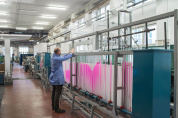 Pipe flows
Pipe flows
 Channel for waves and currents
Channel for waves and currents
 Reynolds experiment
Reynolds experiment
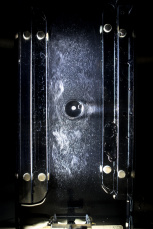 Hydrogen bubble visualization of flows around solid obstacles
Hydrogen bubble visualization of flows around solid obstacles
 Pipe flows
Pipe flows
 Venturi tube
Venturi tube
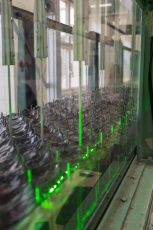 Low flow rate flume
Low flow rate flume
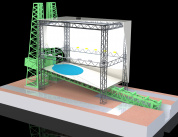 The white chamber
The white chamber
 Cavitation rig
Cavitation rig
 Turbulence box
Turbulence box
 Physical modelling area
Physical modelling area
 2-D Laser Doppler Anemometry
2-D Laser Doppler Anemometry
 Moving flume
Moving flume
 Water conveyance system
Water conveyance system
 Low flow rate flume
Low flow rate flume
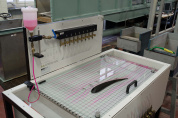 Visualization of irrotational flows around solid bodies
Visualization of irrotational flows around solid bodies
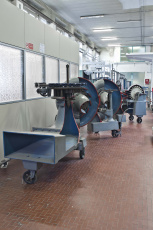 turbines
turbines
TEACHING FACILITIES
Flume for teaching activities dedicated to the study of free surface flow problems (e.g. hydraulic jump, the functioning of weirs etc)
Reynolds experiment for the visualization of laminar, transitional and turbulent flows in pipes
Visualization of irrotational flows around solid bodies
Hydrogen bubble visualization of flows around solid obstacles
Francis, Pelton e Kaplan turbines
Pipe flows for the study of Energy and Hydraulic grade lines
Hydrodynamic cavitation inside a Venturi tube
Orifice flows spilling from reservoirs
RESEARCH FACILITIES
Wave-current flume. Fixed bed flume (length 50m, width 0.6 m, depth 1.0 m) dedicated to the study of waves as well of combined wave-current flows. Waves are generated by a piston-type wavemaker located at the upstream end of the flume. A submerged pump allows for the recirculation of water and the generation of steady currents to be combined with waves
High flow rate flume. Tilting flume (length 18 m, width 0.9 m, depth 1.0 m) dedicated to the study of a wide range of phenomena including, wall turbulence (including smooth, rough and permeable walls), local scouring and testing of prototype-turbines
Sediment flume. Tilting flume (length 18 m, width 0.6 m, depth 0.3 m) dedicated to the study of sediment transport, bed forms and sediment-turbulence interaction
Low flow rate flume. Tilting flume (length 12 m, width 0.5 m, depth 0.6 m) currently employed for the study of dam break flows over rough surfaces
The white chamber. By means of a diffuse and uniform illumination of a cubic space and ad-hoc calibrated high speed cameras, this chamber allows for the measurement of water depths in 3-D dam break flows
Rainfall simulator. Alluminium structure hosting 14000 needles (located at a height of 10m) which allows for the generation of a wide range of precipitation intensities over a surface of 3 x 3.5 m2
Membrane channel flow. Channel flow (test section with length 2.0 m, width 0.2 m, depth 0.01 m) for the study of mass transport phenomena leading to clogging in flows over membranes. The channel is equipped with a chiller to maintain constant water temperature during experiments and with a system that permits the generation of controlled unsteady flow conditions
Cavitation rig. Hydraulic plant dedicated to the study of hydrodynamic cavitation within the context of water disinfection
Turbulence box. Glass walled reservoir (2.0 x 1.0 x 1.0 m) equipped with 126 little pumps controlled by a specific on/off random protocol, which generate homogeneous and isotropic turbulence
Moving flume. Tilting flume (length 2.0 m, width 0.3 m, depth 0.3 m) for field applications and the study of fish swimming performance
Physical modelling area. The size of the hydraulics and fluid mechanics lab allows for the hosting of large-scale physical models, which are employed in support of the design and analysis of hydraulic structures
Measuring instruments: besides, a wide range of pressure and level sensors (mainly ultrasound based) load cells and cameras for flow visualization, the lab is equipped with advanced systems such as:
Stereoscopic Particle Image Velocimetry
50kHz High-Speed Camera
| Type | Experimental and teaching laboratory |
|---|---|
| costantino.manes@polito.it | |
| Staff |
|
